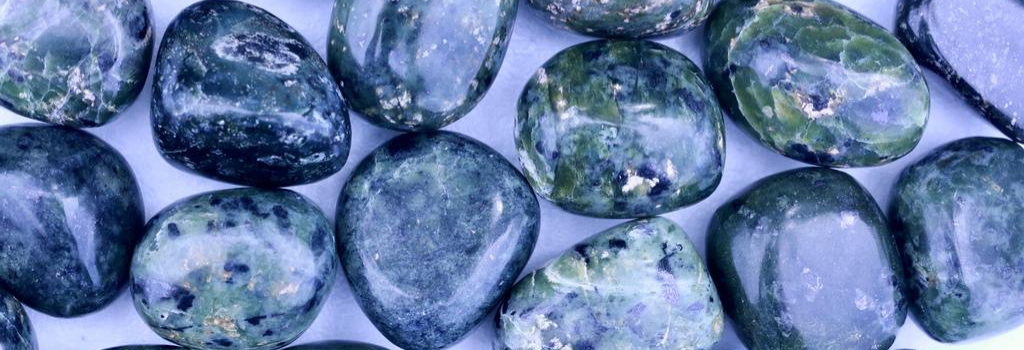What Crystals Should Not Go in Water?
INSIDE: Depending on what materials your crystal is made of, water may damage them. Use this list of what crystals should not go in water to keep your crystals safe.
Whether you come across a crystal naturally, purchase one from a shop, or are gifted a crystal by a friend, you'll want to cleanse them from past energy. Naturally, your first instinct to may be to submerge it in water, but this act of love could do more harm than good for some crystals.
Other reasons you may want to place your crystal in water is to create a crystal elixir by charging the water you are consuming.
All crystals are made up of different minerals and materials and because of this, some crystals can be cleansed and charged in water, and some cannot. Comparatively, some crystals can be charged by the sun, and others will fade or break when exposed to the sun.
One method to determine if your crystals are safe to be placed in water is to understand where they fall on the MoH’s Hardness Scale. This scale rates crystals from 1-10, with 1 rating the crystal as the softest and 10 being the hardest.
A general rule of thumb to ensure your crystals will be safe in water is as follows:
- What crystals should not go in water? = those that are rated 1-5 on the MoH's scale
- What crystals can go in water? = those that are rated 6-10 on the scale
Below is a short list of what crystals should not go in water and the reasons why.
Why Shouldn’t Certain Crystals Be Placed in Water?
In general, the softer the material of a crystal, the more likely it is to dissolve in or be damaged by water.
Here are some additional reasons why many crystals should be kept away from water...
Some Minerals Are Too Soft
Many crystals that cannot be exposed to water are made of minerals that are too soft to handle the water element. When exposed to water, their surface may break off or dissolve.
PLEASE NOTE: The list we have provided below is not a comprehensive list. If any of your crystals are not outlined on this what crystals should not go in water list, do a quick google search to see where your crystal falls on the MoH's scale. Any crystal that is 5 and below will be too soft to handle when being submerged or cleansed in water.
It's External Structure is Too Porous
Some crystals are porous, meaning they have tiny holes on their surface, which will allow water to seep through to the inside. This may cause your crystal to corrode or break apart when water seeps in.
Contain Metals in Crystals Will Rust
Crystals such as Hematite contain metals within them, and when exposed to water, they can rust, change its coloring and challenge the crystal's structural integrity.
What Crystals Should Not Go in Water?
Now, let's look at some of the most popular crystals that should be kept away from water...
Selenite
Selenite is made of gypsum, which is a soft sulfate mineral often used to make plaster, chalk, drywall, and fertilizer.
This stone makes to the ‘what crystals should not go in water’ list because it falls at a 2 on the MoH’s hardness scale. In fact, there are very few other crystals that are softer than Selenite.
Selenite’s minerals are much too soft and porous to handle water and can dissolve easily when mixed with liquid substances.
Fluorite
Fluorite is rated a 4 on the MoH hardness scale. While it can handle short exposure to water to be cleansed, continuous exposure will affect its strength.
This stone's chemical structure is made of Calcium Fluoride. Salt is Sodium Fluoride, and when these two substances are combined, it causes Fluorite to deteriorate. This chemical reaction makes this stone especially unsafe in salt water.
Sodalite
Sodalite falls between a 5 and 6 on MoH’s hardness scale which makes it a crystal that is capable of being cleansed in water, but the trouble lies in soaking your Sodalite in fresh or salt water for longer periods of time.
Sodalite contains cracks that may be difficult to the eye to see, but continuous exposure may widen these cracks to a breaking point over time.
Lepidolite
Lepidolite falls between 2 and 3 on the MoH’s hardness scale. Due to its softness, this stone will unfortunately flake apart if exposed to water. As its flaky material breaks up in water, this beautiful crystal may also lose its shine as a result.
Angelite
Angelite is a 3-4 on the MoH’s hardness scale, making it a fairly soft stone. When exposed to water, its structure may be compromised and can therefore break apart or crumble. Keep this crystal on your ‘what crystals should not go in water’ list.
Apatite
Apatite falls at a 5 on the MoH hardness scale, making its exposure to water questionable. But more importantly, due to cracks on its surface, when Apatite is exposed to water for longer periods of time, it may lead to breakage.
Malachite

Malachite falls between 3 and 4 on the MoH’s hardness scale. It also contains copper, so when it is exposed to water, it has the potential to rust.
We highly suggest keeping this stone on your mental list of what crystals should not go in water as prolonged exposure can lead to leeching of toxic fumes when copper and water combine.
Labradorite
Labradorite falls at about a 6 on the MoH’s hardness scale. Although it is a hard crystal according to this scale, frequent and extended exposure of this crystal to water can still cause damage.
Labradorite is a beautiful, iridescent crystal which can become dull and slightly rough to the touch if submerged in water frequently.
Celestite

Celestite falls between at the 3-4 range on MoH’s hardness scale, making it a fairly soft stone. It can break apart if placed in water for long periods of time.
Pyrite
When combined with water, Pyrite will produce sulfuric acid. It is made of high amounts of iron content, which means when it comes in contact with water, it may cause your crystal to rust or become discolored. Therefore, we suggest keeping this stone on your what crystals should not go in water list.
Calcite
Calcite falls between 3-4 on the scale and comes in many forms. This stone is found everywhere and is the primary constituent of limestone and marble. When exposed to water for long periods of time or frequently, it can begin to dissolve.
Hematite
Hematite falls between 5 and 6 on the hardness scale. Although it is slightly higher on the MoH scale, due to its porous nature and metallic materials, Hematite can rust if exposed to water.
Chrysocolla
Chrysocolla is a very sensitive and soft crystal that falls between the 2-3 range on MoH’s hardness scale. When placed in water, it is very prone to breaking apart and dissolving.
Opal
Although it falls at 5-6 on MoH’s hardness scale, Opal’s internal structure may be compromised if left in water.
An exception to this case is Australian Boulder Opal, which is not as porous as others and can better withstand exposure to water
If you must place your Opal in water, we suggest holding it under tepid running water. Opal is especially susceptible to damage if placed in extreme liquid temperature or salt water.
Jade
Jade falls at 6-7 on the hardness scale, which generally makes it a safe stone to be cleansed under running water. It can, however, be damaged by chlorine in water, so we do not suggest soaking or submerging this stone in water for long periods of time.
Final Thoughts
Whether you are gifted a crystal or purchase from a shop, crystals are precious and powerful healing stones that we want to cherish for a long time. Unfortunately some of our crystals may fall to a regrettable fate if we do not take care of them properly.
This article has outlined what crystals should not go in water but we highly suggest you research any other crystals you have to better understand the best way to cleanse and keep your crystals in prime condition. You can also consult our Crystal Care Guide.
If your crystal does fall on this ‘what crystals should not go in water’ list, do not fret. There are many other ways to cleanse your crystals. We have a guide for that too: Clearing and Charging Crystals.
* Crystals and stones should not be used as a substitute for medical advice or treatment. Please read our full disclaimer notice here.











Leave a comment